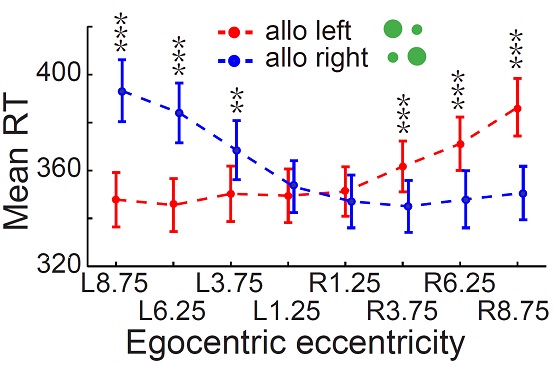Time:2012-06-18
On June 13, 2012, Dr. Mingsha Zhang’s lab at the Institute of Neuroscience, Chinese Academy of Sciences, reported how spatial information from egocentric and allocentric coordinates interacted with each other during spatial perception. This study, entitled as "Asymmetric influence of egocentric representation onto allocentric perception", was published in the Journal of Neuroscience.
Spatial localization is one of the most important cognitive functions for animals surviving in a complex environment. Spatial perception is not only based on observer-centered (egocentric) coordinate, but also on object-centered (allocentric) coordinate. Despite knowledge of separate neural circuits involved in coding spatial information from different coordinates, it is not clear how spatial information from two coordinates interact with each other. To approach this question, Dr. Mingsha Zhang’s group designed a position discrimination task, in which the behavioral response purely relied on the visual target’s allocentric location but not on its egocentric position. Through measuring the manual reaction time in two conditions: the COMPATIBLE (allo- and egocentric representation are the same) and the INCOMPATIBLE (allo- and egocentric representation are different) condition, they found that the task irrelevant egocentric representation markedly influenced allocentric perception. First, in a given egocentric location, allocentric perception was significantly faster in the compatible condition than in the incompatible condition. Second, as the target’s egocentric eccentricity was increased, the speed of allocentric perception slowed down in the incompatible condition but remained unchanged in the compatible condition. Third, incompatibility slowed allocentric perception more in the left egocentric side than in the right egocentric side.
This study used a novel and simple behavior paradigm to demonstrate that egocentric position of the target affected the speed of allocentric perception, while previous studies only found unidirectional effect of allocentric presentation onto egocentric perception. This study shed new light on the mechanism of spatial perception, especially on how our brain integrates spatial information from two coordinates.
This work was carried out by graduate students Yang Zhou and research assistant Yining Liu under the supervision of Dr. Mingsha Zhang. This study was funded by the Shanghai Pujiang Talent Program, and the State Key Laboratory of Neuroscience.

Represents the Mean RTs from 10 subjects. Dots and short vertical bars represent the average RTs and the standard error of the mean, and are displayed as a function of target’s egocentric location (x-axis). Two allocentric representations are plotted in different colors: red for allocentric left and blue for allocentric right. Asterisk denotes the results of statistic test: * P < 0.05, ** P < 0.01, *** P < 0.001.
 附件下载:
附件下载: